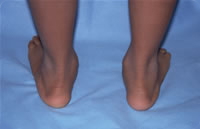What is flatfoot?
Flatfoot is a common foot shape that doctors sometimes call pronated foot. When a person with flatfoot stands up, the arch in the middle of the foot disappears. The foot seems to lie flat on the ground.
Almost all babies are born with flatfoot. Studies estimate that 8 to 9 in every 10 babies born in North America have flatfoot. Studies in other countries have found similar numbers. Children often outgrow flatfoot naturally.
Types of flatfoot
There are 3 types of flatfoot. Knowing which kind your child has helps you and your child’s doctor decide if your child needs treatment and, if so, which kind.
- Flexible flatfoot: Almost all children with flatfoot have flexible, or hypermobile, flatfoot. This means the bones in their feet move easily in relation to each other. When the child stands, the weight of their body presses on their feet, making their arches flatten out. When they sit, taking weight off their feet and letting their feet dangle, the arches appear. This condition is not painful, causes no disability and does not need any treatment. It always affects both feet.
- Flexible flatfoot with a short : This happens very rarely in young children. It affects both feet and may cause pain and disability, like trouble walking, running or playing sports.
- Rigid flatfoot: This is the least common type. Rigid flatfoot most often shows up in people who have a problem with the bones in their feet (tarsal coalition). Some of the bones don’t move as easily as is typical. Whether the child stands or sits, their foot does not appear to have an arch. About 1 in 4 people with rigid flatfoot has pain and disability. About half of the time, rigid flatfoot affects both feet.
What are the symptoms of flatfoot?
When a child has flexible flatfoot – the kind that needs no treatment – we can see an arch in the foot when the child stands on tiptoe or lets the foot hang down.
When children have rigid flatfoot, which may cause pain and disability, we usually cannot see an arch even when they stand on tiptoe.
Some children with flatfoot have pain on the inside or outside of the foot, usually when walking or playing sports.
Orthopedics and Sports Medicine at Seattle Children's
How is flatfoot diagnosed?
We examine your child’s foot and ankle. We look at your child’s feet as they stand up. We may ask your child to stand on tiptoe or dangle their foot in the air as they sit on an exam table.
We also check to make sure the joints in your child’s feet and ankles all move well. If your child’s ankle does not move much, it could mean that the Achilles tendon is shortened or tight. That may be a sign that your child has flexible flatfoot with short Achilles tendon.
If your child’s feet hurt and they have the type of flatfoot that usually is not painful, we may take X-rays to get more details about what is possibly causing the pain.
How is flatfoot treated?
First, we always evaluate your child to find out what type of flatfoot they may have. Your child needs treatment only if flatfoot causes pain or disability.
If your child has normal flexible flatfoot that doesn’t hurt, we recommend no treatment. Your child should wear regular shoes and be treated the same as if their feet had arches.
Non-surgical treatments for flatfoot
- If your child has flatfeet that hurt, we recommend trying arch supports. These can be simple and inexpensive over-the-counter cushioned arch supports or running shoes with built-in arch support.
- To treat flexible flatfoot with a short Achilles tendon, we may try to stretch the Achilles tendon. It is more difficult to stretch this tendon if your child has flatfoot than if they have a typical arch. We need to rotate the foot inward to raise the arch while the Achilles tendon is being stretched. Our physical therapy team can stretch your child’s foot and teach you how to do it at home.
- For flexible flatfoot with a tight Achilles tendon, we suggest you avoid using hard or rigid arch supports. They are often made of hard plastic and can cause more pain.
Surgery for flatfoot
- In rare cases, nonsurgical treatment doesn’t help with flatfoot and children need surgery to relieve their pain.
- In almost all cases that require surgery, the child is at least 8 years old and their Achilles tendon is short. The surgeon makes the Achilles tendon longer and corrects the flatfoot.
- The surgeon lengthens the heel bone (calcaneus) using a . They insert the graft on the outer edge of the middle of the foot. This procedure is called calcaneal-lengthening osteotomy
Contact Us
Contact Orthopedics and Sports Medicine at 206-987-2109 for an appointment, a second opinion or more information.
Providers, see how to refer a patient.
Related Links
- Foot and Ankle Deformities Program
- Orthopedics and Sports Medicine
- Physical Therapy
- Foot problem resources
Paying for Care
Learn about paying for care at Seattle Children’s, including insurance coverage, billing and financial assistance.


